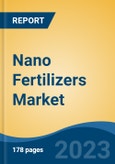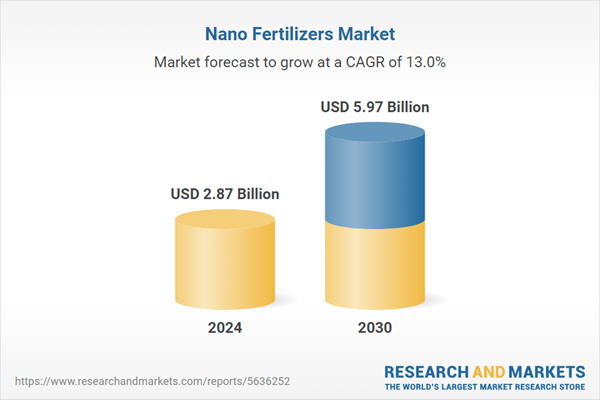Free Webex Call
Global Nano Fertilizers Market was valued at USD 2.87 Billion in 2024 and is expected to reach USD 5.97 Billion by 2030 with a CAGR of 12.98% during the forecast period. Nano-fertilizers are materials at the nanometer scale, typically in the form of nanoparticles, that incorporate macro and micronutrients and are delivered to crops in a regulated manner. These nano-fertilizers provide nutrients to plants through three main approaches. Firstly, nutrients can be encapsulated within nanomaterials such as nanotubes or nano-porous materials. Secondly, they can be coated with a thin protective polymer layer. Lastly, they can be administered as nanoscale particles or emulsions. Speak directly to the analyst to clarify any post sales queries you may have.
10% Free customizationThis report comes with 10% free customization, enabling you to add data that meets your specific business needs.
Nano-fertilizers are categorized into three types: nanoscale fertilizers, nanoscale additive fertilizers, and nanoscale coating fertilizers. Nanoscale fertilizers are created by incorporating plant nutrients into nanoparticles. When traditional fertilizers are enriched with small additions, they become nanoscale additive fertilizers. Nano-fertilizers are applied to the plant rhizosphere in a controlled manner. They contain essential minerals and nutrients like nitrogen (N), phosphorus (P), potassium (K), iron (Fe), and manganese (Mn), either alone or in conjunction with nano-sized adsorbents. The application of nano-fertilizers leads to shorter crop cycles and increased crop production. For instance, the use of nano-fertilizers containing NPK (nitrogen, phosphorus, and potassium) has been shown to boost grain output and reduce the crop cycle by 40 days.
Key Market Drivers
Rising Global Population
The escalating global population is projected to significantly increase the demand for nano fertilizers worldwide. With the world population expected to reach 9.7 billion by 2050, the agricultural sector faces the daunting task of producing enough food to feed everyone. Nano fertilizers, due to their unique properties of controlled nutrient release and increased nutrient use efficiency, are seen as a sustainable solution to enhance crop productivity. They ensure that plants receive precise nutrients at the right time, reducing waste and lessening environmental impacts. Moreover, they improve soil health and crop quality, further contributing to increased yields.The global push towards effective and sustainable farming practices, coupled with the rising need for high-quality food crops, is anticipated to fuel the adoption of nano fertilizers. Emerging economies with rapidly growing populations and escalating food demands, like India and China, are expected to be key drivers in this market expansion. Furthermore, the advancements in nanotechnology and its integration into agriculture are paving the way for innovative nano fertilizer products that can meet the agricultural challenges posed by the global population surge. Hence, the combination of population growth and sustainable agriculture trends is anticipated to drive the nano fertilizer market significantly in the coming years.
Key Market Challenges
Poor Quality of the Products
The quality of products significantly impacts their demand in the market, and the same applies to nano fertilizers. In recent times, there has been growing concern globally about the substandard quality of some nano fertilizers. These inferior products do not meet the required efficacy levels, often leading to disappointing results in terms of crop yield and health. Poor-quality nano fertilizers may lack the correct balance of nutrients, may not break down adequately to deliver these nutrients to the plants, or may even contain harmful impurities. Farmers, gardeners, and other end-users who experience these issues are likely to lose trust in nano fertilizers, leading to a decrease in demand.Furthermore, the negative environmental impact of low-quality nano fertilizers, such as potential soil and water contamination, raises concerns among environmentally conscious consumers, thus further hindering market growth. Regulatory bodies worldwide are also imposing strict guidelines regarding the manufacturing and usage of nano fertilizers. If these concerns are not addressed, the demand for nano fertilizers is expected to decrease globally. Therefore, manufacturers need to prioritize quality control and assurance to maintain consumer trust and ensure the sustainable growth of the nano fertilizer market.
Key Market Trends
Growing Need for Improved High-Efficiency Fertilizers
The escalating demand for high-efficiency fertilizers is anticipated to significantly fuel the global Nano Fertilizers market. Nano Fertilizers, marked by their microscopic particle size and precision delivery, are becoming increasingly sought after due to their ability to improve crop yield and nutrient use efficiency. They allow for targeted delivery of nutrients directly to plant cells, thereby reducing the quantity required and minimizing nutrient waste. As the global population burgeons, the pressure on agricultural productivity has intensified, necessitating more efficient and sustainable farming practices. Traditional fertilizers often lead to nutrient leaching, posing environmental hazards and reducing soil fertility.Conversely, Nano Fertilizers, with their controlled release mechanisms, negate such drawbacks, optimizing nutrient availability and significantly reducing potential environmental impacts. The adaptability of Nano Fertilizers to various crop types and climatic conditions also make them a versatile solution for diverse agricultural contexts. Moreover, the integration of nanotechnology in agriculture is being encouraged by various governments and agricultural bodies globally, further pushing the demand for Nano Fertilizers. Increased awareness among farmers about the benefits of employing such advanced technologies in farming, coupled with the rising need for food security and sustainable agricultural practices, is expected to drive the Nano Fertilizers market growth.
Key Market Players
- AG CHEMI Group S.R.O.
- Indian Farmers Fertiliser Cooperative Limited
- Lazuriton Nano Biotechnology Co., Ltd.
- SMTET Eco-technologies Co., Ltd.
- AC International Network Co., Ltd.
- The Best International Network Co., Ltd.
- WAI International Development Co., Ltd.
- JU Agri Sciences Pvt. Ltd.
- Fanavar Nano-Pazhoohesh Markazi Company
- Nano Green Sciences, Inc.
Report Scope:
In this report, the Global Nano Fertilizers Market has been segmented into the following categories, in addition to the industry trends which have also been detailed below:Nano Fertilizers Market, By Category:
- Nanoscale Fertilizer
- Nanoscale Additive Fertilizer
- Nanoscale Coating Fertilizer
Nano Fertilizers Market, By Raw Material:
- Silver
- Copper
- Aluminium
- Carbon
- Others
Nano Fertilizers Market, By Crop Type:
- Cereals & Grains
- Oilseeds & Pulses
- Fruits & Vegetables
- Others
Nano Fertilizers Market, By Method of Application:
- Soil Method of Application
- Foliar or Spray Method of Application
- Soaking Method
Nano Fertilizers Market, By Region:
- North America
- United States
- Canada
- Mexico
- Europe
- France
- United Kingdom
- Italy
- Germany
- Spain
- Asia-Pacific
- China
- India
- Japan
- Australia
- South Korea
- South America
- Brazil
- Argentina
- Colombia
- Middle East & Africa
- South Africa
- Saudi Arabia
- UAE
Competitive Landscape
Company Profiles: Detailed analysis of the major companies present in the Global Nano Fertilizers Market.Available Customizations:
With the given market data, the publisher offers customizations according to a company's specific needs. The following customization options are available for the report.Company Information
Detailed analysis and profiling of additional market players (up to five).This product will be delivered within 1-3 business days.
Table of Contents
1. Product Overview
2. Research Methodology
3. Executive Summary
5. Global Nano Fertilizers Market Outlook
6. North America Nano Fertilizers Market Outlook
7. Europe Nano Fertilizers Market Outlook
8. Asia-Pacific Nano Fertilizers Market Outlook
9. South America Nano Fertilizers Market Outlook
10. Middle East and Africa Nano Fertilizers Market Outlook
11. Market Trends & Developments
12. Market Trends & Developments
14. Porter’s Five Forces Analysis
15. Competitive Landscape
Companies Mentioned
- AG CHEMI Group S.R.O.
- Indian Farmers Fertiliser Cooperative Limited
- Lazuriton Nano Biotechnology Co., Ltd.
- SMTET Eco-technologies Co., Ltd.
- AC International Network Co., Ltd.
- The Best International Network Co., Ltd.
- WAI International Development Co., Ltd.
- JU Agri Sciences Pvt. Ltd.
- Fanavar Nano-Pazhoohesh Markazi Company
- Nano Green Sciences, Inc.
Table Information
| Report Attribute | Details |
|---|---|
| No. of Pages | 185 |
| Published | March 2025 |
| Forecast Period | 2024 - 2030 |
| Estimated Market Value ( USD | $ 2.87 Billion |
| Forecasted Market Value ( USD | $ 5.97 Billion |
| Compound Annual Growth Rate | 12.9% |
| Regions Covered | Global |
| No. of Companies Mentioned | 10 |









